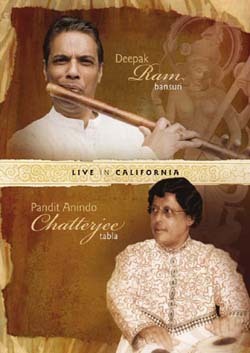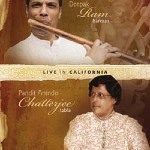- artist:Deepak Ram
- featured artist:Deepak Ram, Pt. Anindo Chatterjee
- release year:2011
- style(s):Classical, Traditional
- country:India
- formats:DVD Video (Digital Versatile Disc)
- record posted by:Golden Horn Records
- label:Golden Horn Records
- publisher:Seher Music Publishing (ASCAP)
- buy this record
Links
The new DVD of the master bansuri player, Deepak Ram “Live in California” with Pandit Anindo Chatterjee on tabla is a wonderful and long-awaited addition to the musical video world.
Those who are new to the bansuri may be drawn to it through an intuition that the instrument is spiritual in nature. More than a cliché, this is in fact the essence of the instrument. Deepak relates the search for the essential question posed by Indian philosophy, “Who am I?,” and notes that archetypal player of the bansuri, Lord Krishna, reminds people that,
“Sound was the first manifestation of being. Sound was the first manifestation of matter.”
The DVD features the colorful 2006 live concert at the Pacific Cultural Center of Santa Cruz, California and includes informative and insightful interviews of both musicians conducted by Ates Temeltas in a relaxed setting. The background information is much appreciated by connoisseurs of North Indian classical music while at the same time helping to give the uninitiated listener a grounded point of reference.
Deepak grew up in a house that contained not only the music of Bollywood and North Indian Classical music, but also the jazz records of John Coltrane, a mixture which would influence Deepak’s playing and approach to this day. Like many Indians, his first exposure to music was that of the great master, Ravi Shankar. He remembers listening to the ubiquitous, “Call of the Valley” - the most popular album of classical Indian music that also featured the bansuri. The sound of the instrument was so attractive to him that he decided to make it his life’s work to master it.
The spiritual element of Deepak’s playing is not only clearly evident from the breathtaking unfolding of the four ragas which are developed in the concert, but also through the close-ups of the camera and through Deepak’s words directly:
“What bansuri means to me is: Its an extension of my own breath. Breathing is what keeps us alive and is something that happens constantly – it’s the very essence of life, the very essence of being. This is also something which classical yogic studies focus on – the breath. What bansuri is - if I can translate this thing that is part of me through this bamboo and create something which hopefully is beautiful to me and to others who listen to it.”
Deepak describes the greatest moment in his life in Geneva, where he attended the concert of his teacher, Pandit Hariprasad Chaurasia. The master, who had taught Deepak for the past six years asked him to come to his hotel room, where Deepak, on the brink of tears from excitement, played for him. Chaurasia subsequently asked Deepak to play with him for three concerts, an event which was to become a pivotal moment in the student’s career.
A further treat of the DVD is the rare interview of the tabla legend, Pandit Anindo Chatterjee, whose playing is nothing short of telepathic throughout the entire concert. Anindo Chatterjee is recognized as one of India's most eminent tabla players. He was taught by his uncle, the sitar player Pandit Biswanath Chatterjee, when he was just four years old. By five he was All India Radio's youngest artist and at six Anindo became a disciple of Padmabhushan Gyan Prakash Ghosh, with whom he studied for over twenty years. Insiders of North Indian classical music praise Anindo for his highly developed sense of balance and proportion, clear tone and variation of timbre, as well as his attentiveness and sensitivity to the soloists whom he accompanies. His resume is studded with honors and awards, including the President’s award in 1970.
The concert that this DVD documents reveals the performers in the relaxed setting of a small concert hall, which enables the camera to capture the intimacy of their interaction in a way which can’t even be experienced live. There four ragas, Janasamohini, Charukeshi, Jog and Sindhu Bhairavi, are developed exquisitely, possibly not as slowly as they would have been had they been performed in India – a blessing perhaps for the western listener, as the Jor (the rhythmic portion whereby the drum interacts closely with the soloist) generally enters sooner than normal and creates excitement through the climax.
There are unusual turns of chromatic phrases, some almost jazz-like, although remaining within the demands of the raga, which clearly show the mastery of Deepak and easily invite the comparison with Coltrane, if only by the exhuberant virtuosity and occasional similarity of musical design. Anindo at times creates beautifully wrought tabla cascades of sound against the long tones of the flutes, stopping at exactly the point where the bansuri picks up speed or ends his phrase.
The DVD is the perfect entry point for the listener who is largely unfamiliar with North Indian Classical music, and a fantastic addition for those already familiar with this music, who have awaited a close encounter with an adventurous duo enmeshed in the tradition but willing to extend its boundaries.



